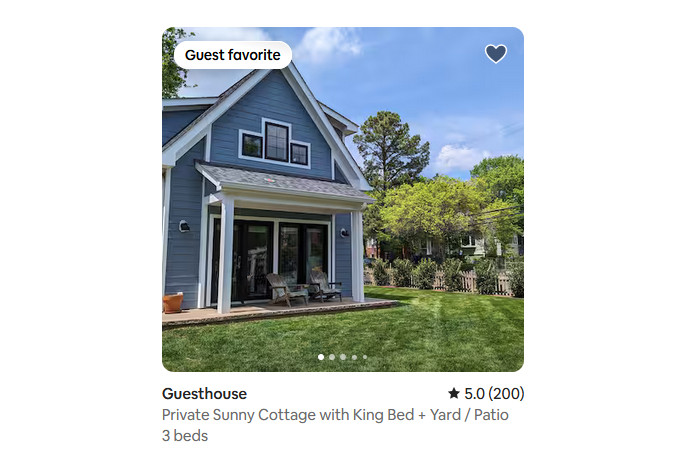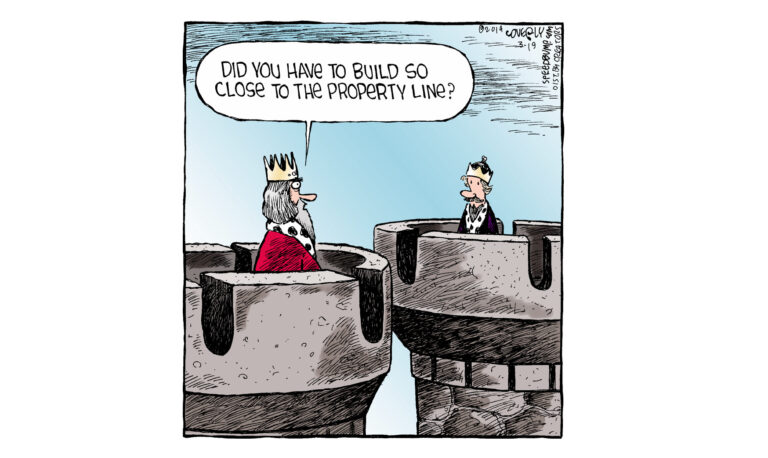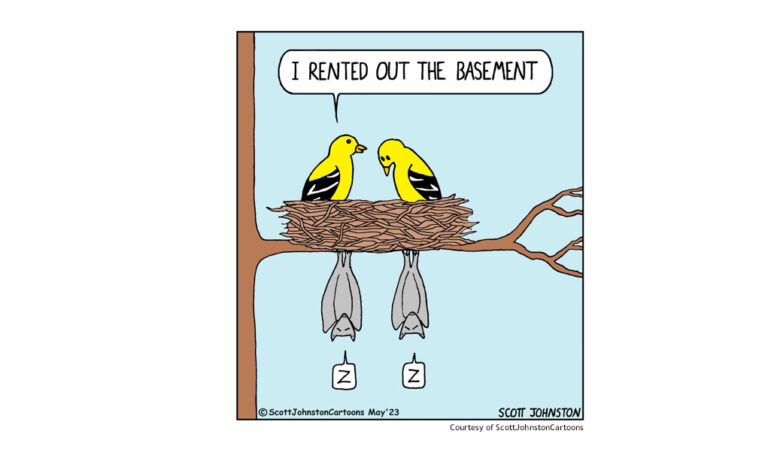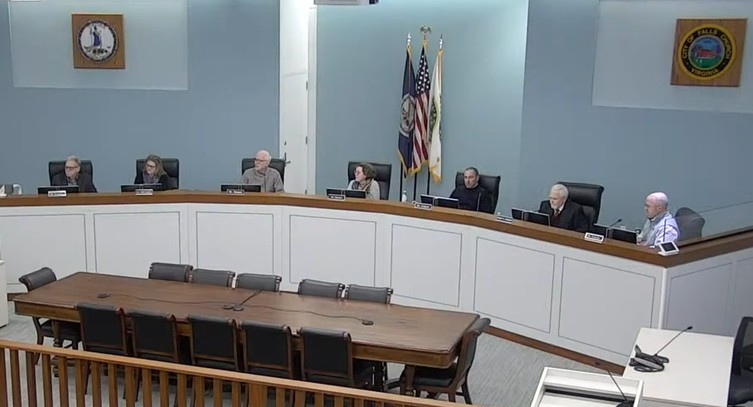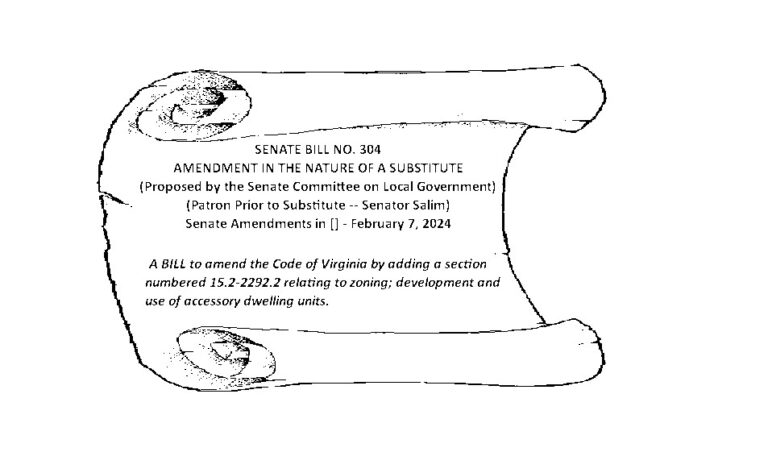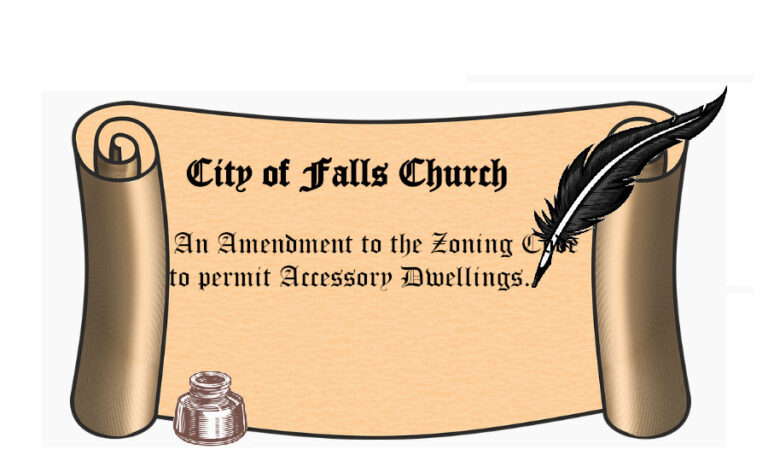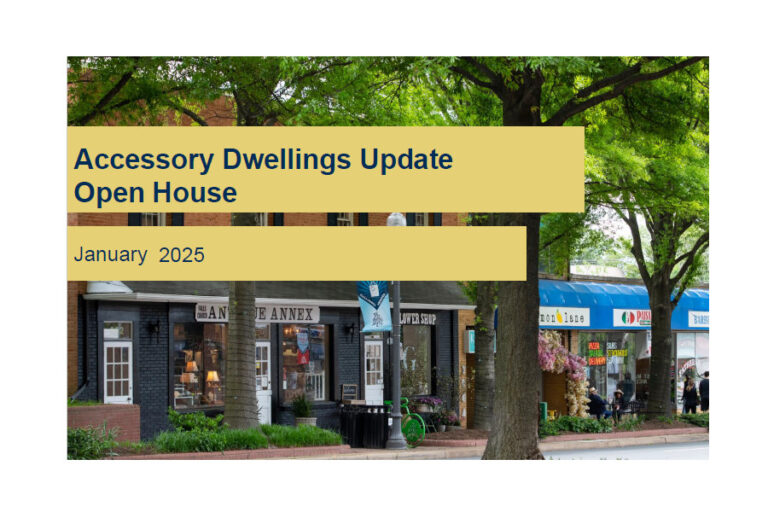No Short-Term Rentals Allowed in the Latest Accessory Dwellings Code but Impacts on Neighbors Remain, First Reading Passed
Update: Current City Schedule of Meetings on ADs
Falls Church City has scheduled two Community Open House meetings on the proposed zoning code changes on accessory dwellings endorsed by the City Council on November 25, 2024. They are:
- Sunday, January 12 at 10 AM – 12 noon at the Mary Riley Styles Public Library in the lower level conference room; and
- Tuesday, January 14 at 6 – 8 PM at the same location.
It is not clear if there will also be outreach sessions in individual neighborhoods, or by voting zone, as previously pledged.
Schedule for additional meetings
The current schedule for additional Planning Commission and City Council meetings follows. It can be found on the City’s “Accessory Dwellings Update” official website.
| January 15, 2025 | Planning Commission |
| January 22, 2025 | Planning Commission |
| January 27, 2025 | City Council |
| February 19, 2025 | Planning Commission |
| March 5, 2025 | Planning Commission Public Hearing |
| March 10, 2025 | City Council |
| March 24, 2025 | City Council Final Consideration |
Latest staff report includes survey by the City Assessor
The staff report for the January 15 Planning Commission meeting on this issue includes on pages 19-20 a survey by the City Assessor’s Office finding “31 improvements that resemble accessory dwellings but that aren’t considered as such under the City’s zoning regulations,” together with an initial fiscal impact estimate based on the size and bedroom count per unit.
The most recent Falls Church Pulse summary of the City Council and Planning Commission discussions on accessory dwellings can be found below.
References
- City “Accessory Dwellings Update” official website.
- Accessory Dwelling staff report, Planning Commission meeting, January 15, 2025.
December 14, 2024
Summary
- On November 25, 2024, the City Council voted 5-2 to grant first reading to proposed amendments to the City Code regarding accessory dwellings (ADs).
- On December 4, the Planning Commission welcomed the Council’s decision to prohibit short-term rentals of ADs but continued to express serious reservations about the absence of an owner occupancy requirement and allowable height and setbacks from lot lines.
- At the December 9 City Council meeting, citizens made additional public comments:
- questioning the need for a new AD ordinance to address the requirements for more space for family members or caretakers in light of the existing allowance for internal and attached ADs;
- recognition that rental use makes little sense given the thousands of new apartments at similar expected costs;
- the inability of elderly persons needing additional income to pay cash or take out a mortgage for detached units;
- and the dramatic impacts on neighborhood esthetics, including clear-cutting of trees, additional parking on neighborhood streets, and uncertainty about what will be built.
- Another member of the public wrote in asking for a public referendum on the issue.
- On the other hand, there were also suggestions for even greater height and split ownership of the housing units.
- City Manager Wyatt Shields said the City will plan meetings with each voting ward, as requested by Council Member Marybeth Connelly, although dates have not yet been set.
- The draft ordinance was referred to the Planning Commission for a recommendation by March 21, 2025, and anticipated second reading and public hearing before the City Council on April 7, 2025.
Changes since early November
City staff responded to concerns raised at the City Council and Planning Commission work session discussions on October 31 and November 4, respectively, with specific changes to the draft Code amendments on accessory dwellings. For a summary of those discussions, see the Pulse post, “Staff’s Accessory Dwelling Code Does Not Regulate Short-Term Rentals or Require Owner Occupancy,” November 18, 2024.
Key changes included:
No change to grading plan requirements to assess stormwater runoff impacts
In response to Council and Planning Commission requests, City staff indicated that while it is permissible under State Code to reduce the 2,500 square foot minimum land disturbance required for a grading plan for detached accessory dwellings, staff are not aware of jurisdictions that have done so. Staff believe that further study of the administrative and regulatory impacts of lowering the 2,500-square foot threshold would be needed. (Such a measure could enhance consideration of environmental impacts on neighboring lots.)
How many ADs are projected?
Following further review, staff stated that approximately 56% of the 2,400 single-family lots in R-1A and B districts would have adequate space to construct a detached accessory dwelling within City lot and building coverage maximums (assuming that each AD only covered 300 square feet). Nevertheless, staff continued to project that only two detached accessory dwellings would be built each year, with marginal impacts on neighborhoods.
City Council discussion on November 25
At its November 25 meeting, the City Council reviewed the recent changes suggested by City staff and considered whether to grant the new draft first reading. No public hearing had been called for this meeting, but comments from the public were accepted. Members from the public expressed concern about potential impacts on stormwater, schools, City services, and neighboring properties; lack of broad public understanding of the proposal; lack of fiscal analysis or rationale for including townhouses in R-M (Multifamily), but not R-C (City Residential) or TH (Town House) districts; and the lack of an owner occupancy requirement. They suggested deferring first reading until these issues are addressed. Others urged Council to move ahead briskly.
The City Council had an extensive discussion and raised additional questions for further study, including:
A member of the public also asked how construction of an AD would affect the property’s appraisal value and taxes – would this be an incremental or separate appraisal?
Council Member Erin Flynn asked at the conclusion of the session whether it is advisable to keep so many open issues when granting first reading. City Attorney Sally Gillette responded that if Council were to grant first reading and one or more items subsequently changed, Council would have to determine whether these were significant issues requiring a new first reading.
Specific positions of individual Council Members were as follows:
Council Member Laura Downs noted that staff were not suggesting that a large number of ADs would be constructed per year and that nuisance provisions could be used if issues arose. She suggested looking at a minimum 10-foot setback to permit adequate space for shrubbery and trees.
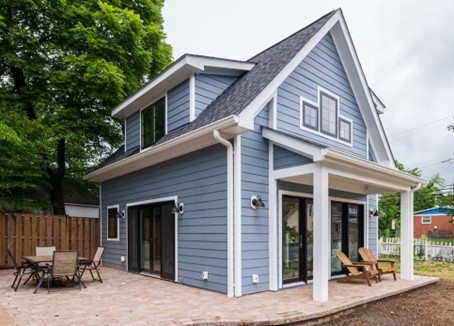
She said, “… our next-door neighbor knocked down their garage and built a two-story garage in its place and they have their au-pair living in there, I’m OK with that, … based on my experience, having now a two-story structure 15 feet from the property line, it does still seem like it’s pretty close to us. … We have less privacy now… It’s a delicate balance between having a more diverse housing stock but also trying to maintain harmony among neighbors … but I am 100% on board with ADUs.”
Council Member Flynn underscored the Council’s responsibility not only to permit property owners to enhance the use of their property, but also to help protect neighbors’ properties and understand the fiscal impacts of the proposed Code.
She continued to believe that the staff draft Code should be referred to the Planning Commission before first reading to incorporate its recommendations, with a public hearing before both the Planning Commission and subsequent Council first reading sessions. She was particularly concerned that the “ping-ponging” of discussions among Council, Planning Commission, and other Commissions has been difficult for the public, and noted that the broader public has only had access to the latest Code draft five days prior to the Council’s meeting.
Noting that owner occupancy is required in regulations adopted by both Arlington and Fairfax Counties and is permitted under the draft State bill, Ms. Flynn suggested that a waiver could be applied if the property owner were to relocate overseas for work. Staff responded that they prefer the ability to permit two rentals.
Ms. Flynn also stated that ADs that didn’t meet the minimum land disturbance requirement for a grading plan would not have a 20% tree canopy coverage requirement, and staff shouldn’t advertise ADs as continuing that requirement.
Finally, she urged that height for ADs be limited to 20 feet and that larger setbacks should be adopted to enable an adequate planting buffer.
Vice Mayor Debora Schantz-Hiscott indicated that the Housing Commission and Environmental Sustainability Council both support this legislation and noted an interest in further environmental impact analysis. She reminded staff that Council had asked to understand what size structure would trigger a grading plan. She said, “I want to continue the discussion on land disturbance … I would like to see data that supports it.”
Council Member David Snyder agreed that the City should provide more flexibility on ADs and welcomed the recommendation to prohibit short-term rentals. However, he said that the potential for as many as 1,200 new detached units would have fiscal impacts and urged that there be more explanation of worst possible outcomes. Finally, he could support Code changes that include owner occupancy but would not vote for the proposal as it is currently drafted.
Council Member Justine Underhill spurred a discussion on the application of the Fair Housing Act, as raised by a member of the public. City Attorney Gillette responded that it would not apply if there were a rental by the owner, but this would require further study; she preferred to remain silent on this point rather than give advice to private individuals, who should rely on their own attorneys. The Council decided to leave this unaddressed for the time being.
Ms. Underhill noted that the housing chart prepared by City staff indicated that most homes built since 1960 were close to the maximum lot coverage and inquired why staff was recommending only one AD per property. Planning Director Paul Stoddard responded that a property owner could cancel a certificate of occupancy for an internal AD and build a detached unit, if they so desired.
Council Member Marybeth Connelly saw the first reading as the official beginning of public consideration of formal Code changes, having previously taken the views of various Commissions and public sessions into account. She suggested bringing meetings or walking tours to neighborhoods by individual voting Ward.
Mayor Letty Hardi thought it would be useful to have more information on when the grading plan disturbance requirement is met, suggesting that all structures should be treated the same. She liked the proposal to manage construction through the use of certificates of origin and the proposal to permit access to water and sewer connections for the main house. She wondered if owner occupancy is unconstitutional, citing a North Carolina case, and supported not having an owner occupancy requirement.
The Mayor supported the current height and setback requirements and could accept prohibiting short-term rentals in response to public concerns, even though Falls Church is not a “hotbed” for tourists. She emphasized that the current process was “bottoms up” and a good one and said that Council cares about the details and getting this right.
Finally, Mayor Hardi said that the City could have been more “progressive” in authorizing two accessory dwellings per lot, permitting the sale of detached ADs, offering pre-approved building plans, or enabling units larger than 1,000 square feet, but was not doing so in this Code amendment.
Voting on first reading
The motion to adopt the resolution amending the Code passed 5-2, with Council Members Flynn and Snyder voting no.
Planning Commission concerns expressed on December 4
The Planning Commission discussion on December 4 also underscored that a number of issues remained outstanding.
Commissioner Phil Duncan noted that the Economic Development Authority (EDA) questions whether AD residents could park on the grass in the front yard, if the AD would have a separate address, and how the tree canopy of young trees would be measured. Staff assured Mr. Duncan that they would look into these issues.
Commissioner Tim Stevens said that the EDA also had questions about what would happen to existing short-term rentals. He asked why R-C districts, which are mainly townhouse districts, weren’t considered for this purpose. He was especially appreciative of the decision to prohibit short-term rentals, which could increase the valuation of properties. He didn’t see a need to revisit the 2,500 square-foot disturbance minimum, but thought a graphic demonstrating the likely disturbance around an AD would be helpful.
Commissioner Andrea Caumont would support allowing conditional internal ADs in townhouses in R-C and TH districts to be consistent. She preferred allowing one internal and one detached unit per lot; staff didn’t think we were ready for that yet. She also proposed a 25-foot height at a 7-foot setback, based on comparable ratios with accessory structures.
In an exchange on Board of Zoning Appeals (BZA) consideration of conditional ADs in townhouses, Commissioner Brent Krasner insisted that the Planning Commission should have an opportunity to provide its recommendation. Staff promised to get back to him on this.
Commissioner Krasner said that with first reading, review becomes more serious and narrower. He strongly objected to staff saying that going forward the City would only regulate use of a structure if someone were living in it. He stated that the regulation should be on the thing itself, as well as clarifying what a cooking appliance is.
Mr. Krasner also strongly disagreed with staff on the owner occupancy issue and recommended that it be included, as in Arlington and Fairfax Counties, noting that a waiver of 1-3 years is feasible if the owner has to temporarily move overseas.
He said if a conversion of a garage removed that parking space, it should be accounted for elsewhere.
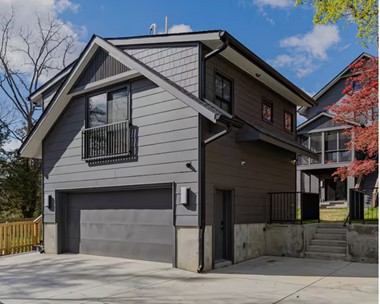
On setbacks, Commissioner Krasner said the AD should meet the requirement for that district, either 10- or 15-foot setbacks. A five-foot setback for a 20-foot structure is not sufficient – one can barely plant in that space and it does have an impact on neighbors. Twenty-five-foot structures would also be too tall, he added. If there is an undersized lot, any detached AD should have to go to the BZA.
Mr. Krasner said, “We are getting up to 20 and 25 ft. That’s really tall. 5-foot setbacks at 20-feet tall is way too close. … If they are going to build essentially a little house, it should have the same setback [as the main house].”
Commissioner Sharon Friedlander agreed with Commissioner Krasner, and especially with regard to owner occupancy; if there were no requirement for an owner to occupy either the main house or the AD, she believed it would change the nature of the community. She said we now have short-term rentals with just a cooktop or a microwave, which opens up a slippery slope.
She was also concerned about the 1,000-square foot size permitted, noting, “I don’t understand why we would not go [with] the industry standard size of 900 sq ft maximum. … You could do two floors of 20 ft x 20 ft [800 sq ft] … or 1 ½ stories of 20×30 and 20×15 [900 sq ft] … why would we be increasing that to allow an additional bedroom?”
In addition, Ms. Friedlander said a 20-foot height to the midline of the roof is too high for an accessory structure. “I personally have structures that are 3 ft from the line … my neighbors could easily…, under the way this is written now, go up 20 ft. That’s to the midline of the roof, so that’s almost 29 ft [actual height], 3 ft from my property line in my garden. So I still think that we are too high at 20 ft.” She proposed a 15-foot maximum at the midline, actual height of about 23 feet, which would still permit two stories with a 10-foot ceiling in each.
Commissioner Derek Hyra said he was glad staff had changed position on short-term rentals, but said we have to figure out how to enforce the new prohibition. He agreed, along with Commissioners Krasner and Friedlander, that there should be an owner occupancy requirement, otherwise the City risks attracting investors seeking to maximize their profit and to own multiple lots. He said this would invite disruption of our neighborhoods, as we would be the only jurisdiction permitting them to own both the primary home and the AD.
Commissioner Hyra underscored that there had been no effort to provide a benefit for affordable housing, as he had insisted. He also asked staff to do the financial analysis and assess the potential impact on property taxes, and then define how much could go into the affordable housing fund.
Chair Robert Puentes agreed on the need for enforcement mechanisms and with Commissioner Hyra on having staff conduct a financial analysis.
Schedule going forward
In light of staff shortages within the Planning Department, the December walking tour and public town hall sessions have been postponed. The next meetings on ADs will be:
References
- Accessory Dwellings Staff Report, November 25, 2024. This report provides staff’s recommendations for Code changes on accessory dwellings. It was also provided to the Planning Commission.
- City Council meeting, November 25, 2024. This official video will not display properly on a small screen as it includes the agenda.
- City Council meeting, November 25, 2024. YouTube video.
- Planning Commission meeting, December 4, 2024. This official video will not display properly on a small screen as it includes the agenda.
- Planning Commission meeting, December 4, 2024. YouTube video.
- City Council meeting, December 9, 2024. This official video will not display properly on a small screen as it includes the agenda.
- City Council meeting, December 9, 2024. YouTube video.

